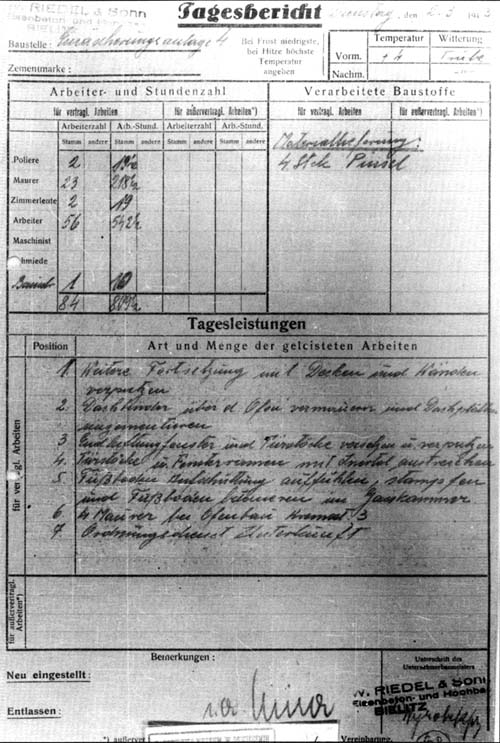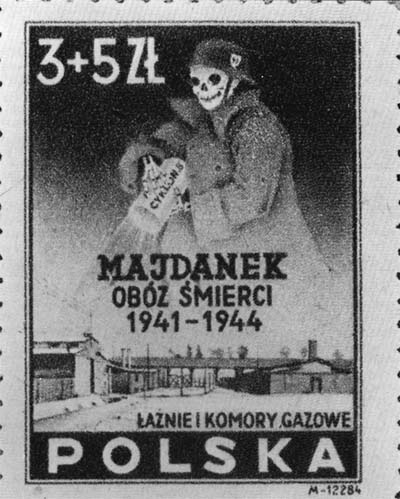|
|
 |
 |
AUSCHWITZ:
Technique
and Operation
of
the Gas Chambers © | |
|
| |
 |
Back |
 |
Contents |
Page 555 |
 |
Home
Page |
Forward |
 |
| |
 |
- - |
Photo
28:
[PMO file BW 30/28, page 68]
(PMO microfilm
1256) |
|
| |
|
| Tagesbericht.
Einäscherungsanlager 4 [Krematorium IV]. In this daily report for
2nd March 1943, again under item 5, we read: |
|
| · |
Fussboden Auffühlen, Stampfen
und Fussboden betonieren im
Gas[s]kammer / |
|
| |
Cover floor with hard fill, tamp
down and concrete floor in gas chamber |
|
|
Photo 29
(Personal archives)
Polish paper stamp
depicting Death in SS uniform pouring Zyklon B over the Maidenek
concentration camp, issued on 29th April 1946 and valid until 1st
July 1946. 218,000 stamps were printed. Designed by J Wilczyk,
photoengraved by the Cracow People's Press, Perforation 10 3/4.
[Source: “Michel”stamp catalogue. Schwanenberger Verlag
GmbH. München] |
 |
| Translation: |
| |
| · MAJDANEK DEATH CAMP
1941-44 |
| · BATHS AND GAS CHAMBERS |
| · POLAND | |
|
| He returned to this theme at the end of his speech: |
| |
Hydrocyanic acid does not leave such deep, indelible
traces unless it has been used for months and months so that it
penetrates deep into the walls. |
The red ochre bricks stained with dark blue were for him
material and visible proof of the existence of homicidal gas
chambers. The problem, for there is one, is that the gas chamber
presented has all the characteristics of a DELOUSING installation. I
am not saying that it was never used to kill people, for that is
still possible, but the traces of Prussian blue are an absolutely
certain indication of use for delousing purposes. At Birkenau the
west wing of BW 5a is a typical example: the bricks of the walls are
stained with Prussian blue, especially in the area of stoves inside
that were used to bring the room up to the evaporation temperature
of hydrocyanic acid. On the outside there are two holes where the
extractor fans were fitted. There are two protective air locks for
access. On two Auschwitz Bauleitung plans, 801 of 8th November 1941
and 1715 of 25th September 1942, this wing is labeled “GASKAMMER”.
It is a gas chamber, but for delousing [Entlausung]. What is more,
the gas-tight door of a Kanada I delousing gas chamber had an
inspection peep-hole — a photograph in the “Album
d’Auschwitz” taken in May or June 1944 proves it. But how
can we be certain that the indications on the drawings corresponded
to the real use made of it? According to the technical manuals and
the accounts of former prisoners, the contact time with hydrocyanic
acid for effects to be deloused varied from several hours to a whole
day, depending on the quantity of the product used, and this
explains the impregnation of the walls. By contrast, in homicide
gassings, the quantity of Zyklon B used was smaller, man being more
sensitive than lice or bugs to hydrocyanic acid. A little of the
poison injected was inhaled by the victims and the rest was removed
by the extractor fans, so that the contact time was brief and the
walls did not have the time to become impregnated. In fact, in the
ruins of the Krematorium II gas chamber, it is not possible to see
any blue-stained bricks in its walls. It was the role of the
officials of the Maidenek Museum to explain all this to Maître
Jouanneau. Furthermore, this Museum gave him part of a plan [the
left side of that presented as Photocopy 31] showing
“Gaskammern für Zyklon Blausäure” as evidence of the existence of
homicidal gas chambers, which is a false interpretation of this
plan. This exhibit [No 80] appears in the file of evidence against
Faurisson. It is simply a project, never implemented, for a mixed
delousing installation using Ventox [acrylonitrile] and Zyklon B.
Any Degesch technician would confirm this. At the CDJC in Paris I
became acquainted with the documents and photographs given to Maître
Douaneau by this Museum. I am sorry to say, and I am not the only
one in the West, that the Maidenek homicidal and/or delousing gas
chambers are still waiting for a true historian, which is mildly
upsetting in view of the fact that the camp fell into the hands of
the Russians intact since 1944.
Faurisson called the mass of
documents that Maître Jouanneau had brought back from Poland a
“shameful hotchpotch”. In this he himself showed shameful duplicity,
for the “revisionist cell” had been delighted to receive such good
historical material on Auschwitz, and translated into the bargain.
These involuntary “gifts” enabled us to advance more rapidly than
our adversaries. It is not enough to possess a piece of evidence, it
is also necessary to be able to exploit it fully. Maître Jouanneau’s
exploitation of the BW 30/31 file, known as the “Metalworking shop”
file, was disastrous. He sited Order No 71 of 8h March 1943
requesting the: | |
| |
AUSCHWITZ:
Technique
and operation
of the gas chambers
Jean-Claude Pressac
© 1989, The
Beate Klarsfeld Foundation |
 |
Back |
Page 555 |
Forward |
 |
|

